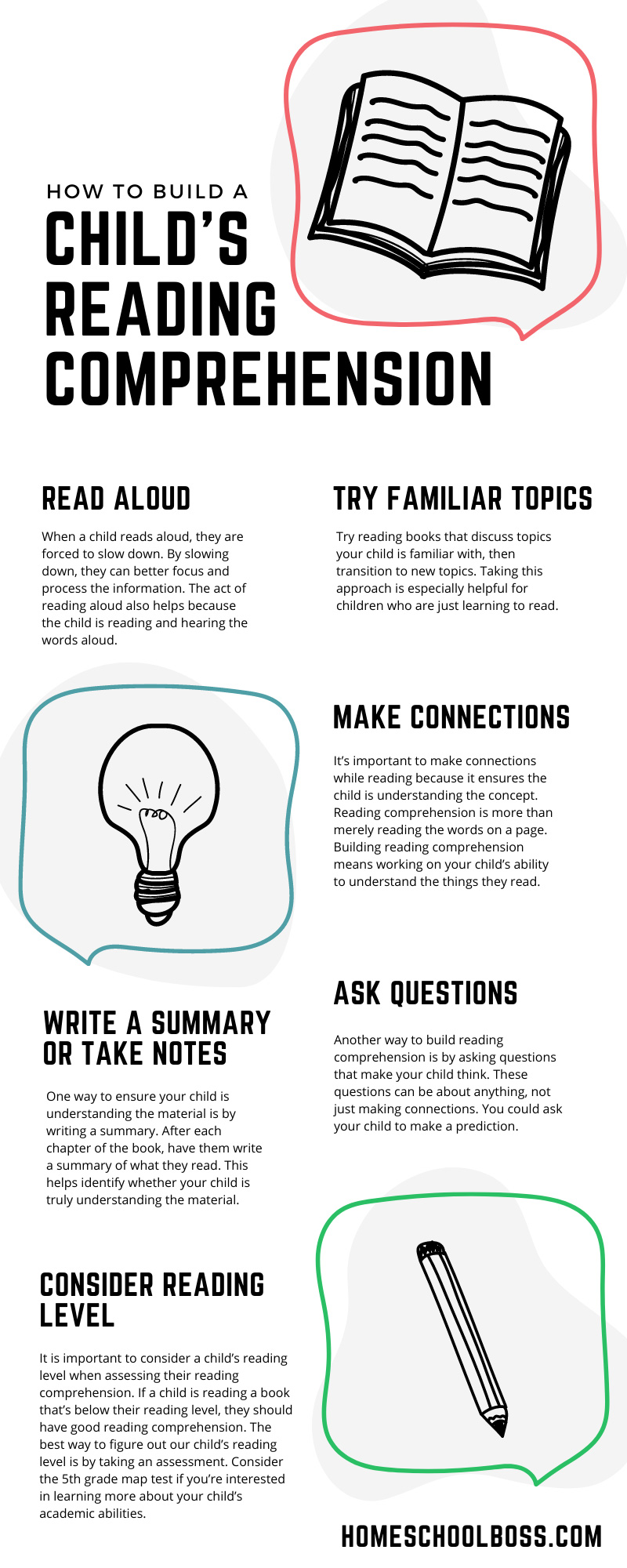Children start learning to read at a young age but developing reading comprehension is an ongoing process. Prioritizing reading comprehension is important because children read throughout their education. Many parents worry their child isn’t up to speed with reading comprehension, but luckily there’s a handful of things you can do to boost their understanding. If you’ve ever wondered how to build a child’s reading comprehension, you’ll find the following suggestions helpful.
Read Aloud
Sometimes when reading to oneself, it can feel like the information is going in one ear and out the other. The material doesn’t always stick, which means reading that part over again. Some people don’t re-read and simply move on. For obvious reasons, this is not good for reading comprehension. If a child is skipping over the difficult parts, their reading comprehension won’t improve. One suggestion for how to build a child’s reading comprehension is by reading aloud. When a child reads aloud, they are forced to slow down. By slowing down, they can better focus and process the information. The act of reading aloud also helps because the child is reading and hearing the words aloud.
Another suggestion is that you read aloud to your child. This is a good way for a child to hear and see the words in a book. Reading to a child daily is helpful because it sets a routine in place. Like anything else, being consistent is important. Reading aloud with your child encourages them to build reading into their routine. Anything done daily is sure to improve over time, so consider reading aloud with your child once a day. This can be during school hours or after school. Many families read aloud before bed, so this may be an option to consider.
Try Familiar Topics
Reading comprehension is all about understanding what’s on the page. How can a child understand something in a book that they don’t understand in real life? This is a great question. Children might struggle to understand a book about something they’ve never experienced in real life. Try reading books that discuss topics your child is familiar with, then transition to new topics. This is a great way to build your child’s reading comprehension because they’re already familiar with the topic. This means they’ll have an easier time understanding what they’re reading. Taking this approach is especially helpful for children who are just learning to read. If you’re working on building your child’s reading comprehension, start with familiar topics and then slowly transition into new topics.
Make Connections
It’s important to make connections while reading because it ensures the child is understanding the concept. Reading comprehension is more than merely reading the words on a page. Building reading comprehension means working on your child’s ability to understand the things they read. There are many ways to make connections in a book. One example is making a connection between the book and real life. If the setting of the book is in a different state, you could talk about that state with your child. How is the state portrayed in the book? Does it seem accurate? This gets children thinking about the book and real life, which is making a connection. You could also discuss a character’s personality in the book. Who does this character remind your child of? Is there a friend or celebrity this character reminds them of? These are great ways to make connections because it gets the child thinking about how the book is similar to the real world.
Ask Questions
Another way to build reading comprehension is by asking questions that make your child think. These questions can be about anything, not just making connections. You could ask your child to make a prediction. For example, ask them how they think the story might end. You could also ask questions about the plot. For example, you could ask your child how they think the main character is feeling. If they don’t know the answer, you could go back together and identify proof of their feelings. Asking questions helps identify what your child is struggling with. If you go through the whole book without asking questions, you might assume the child understands the material, when in fact that is not the case.
Write a Summary or Take Notes
Sometimes reading the words is easy, but understanding the topic is difficult. One way to ensure your child is understanding the material is by writing a summary. After each chapter of the book, have them write a summary of what they read. One way to test reading comprehension is by asking your child to write a summary without looking at the book. This helps identify whether your child is truly understanding the material.
If a child struggles with writing a summary, encourage them to write small summaries after each paragraph. Writing down what you read helps process the information, which helps build reading comprehension. Taking notes while reading is also beneficial to many people. Sometimes it’s difficult to absorb all the information in a book, so writing notes or a summary helps process the information. If a child struggles to write a summary or take notes, this is an indication that they’re struggling with reading comprehension.
Consider Reading Level
It is important to consider a child’s reading level when assessing their reading comprehension. If a child is reading a book that’s below their reading level, they should have good reading comprehension. It is important to know your child’s reading level, but not everyone can accurately say that they know this information. The best way to figure out our child’s reading level is by taking an assessment. If your homeschooler is between grades 2 and 5, it can be difficult to determine what they’re ready to learn or read. Consider the 5th grade map testif you’re interested in learning more about your child’s academic abilities. This test will help you choose reading material for your child based on what they’re ready to learn.
Homeschool Boss provides resources to minimize the stress that comes with homeschooling. We offer the NWEA MAP Growth test because it’s adaptive, cross-grade, online, and untimed. This test provides a wealth of information to families so they can maximize their child’s education. Let us know if you have any questions about MAP Growth, as we’re always happy to help.


Pingback: What Is Reading Comprehension and Why Is It Important?
Pingback: Summer Learning Activities for your Middle Schoolers
Pingback: Common Signs of a Learning Disability
Comments are closed.